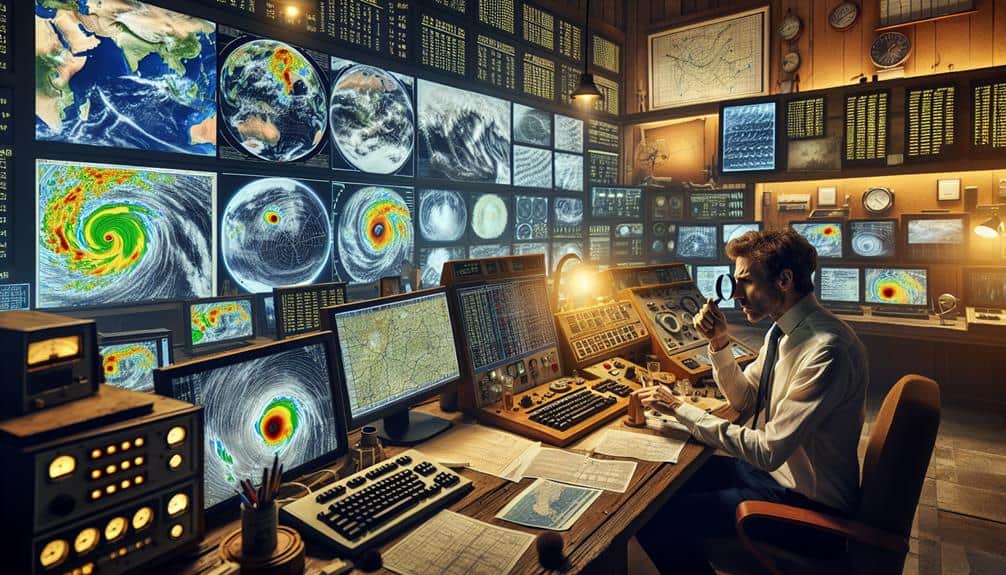To track storm paths like pros, we leverage advanced tools and data-driven strategies. We start with RadarScope and Storm Shield for precise radar data and customizable alerts. Next, we monitor satellite imagery from platforms like GOES-R and Himawari to visualize cloud cover and precipitation. By understanding weather models such as GFS and ECMWF, we decode intricate patterns and improve forecast accuracy. We also analyze real-time satellite data, Doppler radar, and wind patterns to track storm dynamics. Ultimately, historical data analysis using advanced algorithms refines our predictive models. Follow these steps and you'll master storm tracking.
Key Points
- Leverage RadarScope for detailed radar data to analyze storm intensity and movement.
- Use satellite imagery from GOES-R or Himawari for real-time views of storm systems.
- Monitor weather models like GFS and ECMWF for detailed simulations and ensemble forecasts.
- Analyze current wind patterns and Doppler radar readings to understand storm dynamics.
Use Advanced Weather Apps
We can leverage advanced weather apps, such as RadarScope and Storm Shield, to track storm paths with high precision and real-time data. These applications provide storm chasers with essential tools for accurate weather forecasting and decision-making.
By utilizing RadarScope, we gain access to Level 3 radar data, allowing us to analyze reflectivity, velocity, and dual-polarization data. This high-resolution information is vital for pinpointing storm intensity and movement, enabling us to predict potential impact zones.
Storm Shield, on the other hand, offers enhanced alert systems and customizable notifications. This guarantees we receive real-time updates on severe weather conditions, facilitating rapid response and situational awareness. The app's integration with NOAA weather alerts enhances our ability to stay informed about developing storms, which is invaluable for maintaining our safety and freedom during storm tracking.
Both apps are essential for storm chasers committed to precise weather forecasting. Their advanced features allow us to interpret complex meteorological data efficiently, making informed decisions to navigate storm paths effectively.
Monitor Satellite Imagery
In addition to leveraging advanced weather apps, monitoring satellite imagery provides us with detailed views of storm systems from a macro perspective, enhancing our ability to track their development and movement. Satellite imagery allows us to visualize cloud cover, precipitation patterns, and the structure of weather systems in real-time. This extensive information equips us to make more accurate predictions about a storm's trajectory and potential impact.
By interpreting radar data alongside satellite images, we gain a dual-layered understanding of storm dynamics. Radar captures precipitation intensity and movement, while satellite imagery shows the larger atmospheric context. Combining these meteorological tools, we can pinpoint significant features such as storm fronts, eye walls in hurricanes, and areas of intense convection.
Utilizing high-resolution satellite imagery platforms, such as GOES-R series or Himawari, we can observe storms in great detail. These tools provide frequent updates, enabling us to monitor changes as they happen. This real-time data is essential for making informed decisions and ensuring our safety.
Understand Weather Models
Frequently, grasping weather models is crucial for accurately predicting storm behavior and potential impacts. By analyzing these models, we can decode intricate weather patterns and improve our forecast accuracy.
Various models, such as the Global Forecast System (GFS) and the European Centre for Medium-Range Weather Forecasts (ECMWF), provide detailed simulations based on current atmospheric data. Each model has its strengths, and comparing their outputs allows us to refine our predictions.
We must pay close attention to initial conditions, as they greatly influence model outcomes. Small discrepancies in temperature, humidity, and wind speed can lead to significant differences in projections. By cross-referencing multiple models, we minimize uncertainties and enhance our understanding of potential storm paths.
Furthermore, ensemble forecasting, which runs multiple simulations with slightly varied initial conditions, helps us gauge the range of possible scenarios. This approach offers a more thorough view of potential storm trajectories, improving our preparedness.
To utilize the full potential of weather models, we need to stay updated on the latest advancements in meteorological science and technology. Embracing these tools empowers us to make informed decisions, ensuring our safety and independence in the face of impending storms.
Track Storm Movement
Accurately tracking storm movement involves analyzing real-time satellite data, Doppler radar readings, and wind patterns to monitor the storm's progression and predict its future path. By leveraging these tools, we can gain vital insights into a storm's direction and speed, which are necessary for storm chasers and emergency preparedness.
To track storm movement like pros, let's break down the process:
- Real-Time Satellite Data: Satellite imagery provides an all-encompassing view of the storm's structure, including cloud formations and precipitation areas. This data helps us identify the storm's center and track its movement over time.
- Doppler Radar Readings: Doppler radar measures the velocity of precipitation, allowing us to detect wind patterns within the storm. This information is essential for understanding the storm's dynamics and potential changes in its path.
- Wind Patterns: Analyzing surface and upper-level wind patterns gives us insight into the steering forces affecting the storm. By examining these patterns, we can predict the storm's future trajectory with greater precision.
- Model Comparisons: Comparing data from multiple weather models helps us validate our predictions and adjust our tracking methods accordingly. This multi-model approach enhances our overall precision and reliability.
Analyze Historical Data

While real-time data is invaluable for tracking ongoing storm movements, analyzing historical data allows us to identify patterns and enhance our forecasting accuracy. By delving into past storm events, we can isolate recurring storm patterns and understand their frequency, intensity, and pathways. This process involves thorough data analysis where we use statistical tools and models to interpret historical datasets.
We start by collecting extensive data from past storms, including wind speeds, pressure readings, and precipitation levels. Advanced algorithms can then identify correlations and trends within this data. For instance, we might discover that certain regions experience higher storm activity during specific months. By understanding these storm patterns, we can predict future events with greater precision.
Moreover, analyzing historical data helps us to refine our predictive models. We can calibrate these models based on past inaccuracies, improving their reliability. This iterative process ensures that our forecasts are continuously evolving and becoming more precise.
Ultimately, the ability to predict storm paths with higher accuracy empowers communities to prepare more effectively, minimizing damage and enhancing safety. By leveraging data analysis and historical storm patterns, we achieve a more secure and informed approach to storm tracking.
Frequently Asked Questions
What Equipment Do I Need to Track Storms Effectively?
To track storms effectively, we need radar technology, GPS trackers, and weather stations. Storm chasers rely on these tools for precise data and real-time updates, giving us the freedom to anticipate and respond to storm paths accurately.
How Can I Distinguish Between Different Types of Storms?
To distinguish between different types of storms, we use storm classification systems and focus on identifying storm characteristics like wind speed, pressure changes, and precipitation patterns. Accurate data collection guarantees our freedom to predict and prepare effectively.
What Are the Key Safety Measures for Storm Tracking?
In the eye of the storm, we prioritize emergency preparedness and weather awareness. We'll stockpile supplies, maintain communication devices, and stay informed with real-time data, ensuring our safety and freedom during severe weather events.
Which Websites Offer the Most Reliable Storm Tracking Information?
For reliable storm tracking information, we recommend using NOAA, Weather Underground, and AccuWeather. These sites provide accurate data essential for storm chasing. Additionally, weather apps from these sources offer real-time updates, enhancing our tracking capabilities.
How Do I Interpret Various Weather Alerts and Warnings?
Understanding radar and interpreting satellite data are essential. We need to decode weather alerts and warnings precisely. Tornado warnings mean immediate action; flood advisories suggest caution. Let's empower ourselves with accurate information for ultimate freedom and safety.

